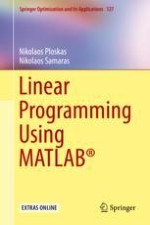2017 | OriginalPaper | Buchkapitel
9. Revised Dual Simplex Algorithm
verfasst von : Nikolaos Ploskas, Nikolaos Samaras
Erschienen in: Linear Programming Using MATLAB®
Aktivieren Sie unsere intelligente Suche, um passende Fachinhalte oder Patente zu finden.
Wählen Sie Textabschnitte aus um mit Künstlicher Intelligenz passenden Patente zu finden. powered by
Markieren Sie Textabschnitte, um KI-gestützt weitere passende Inhalte zu finden. powered by
